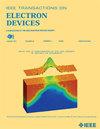Enhancing Ferroelectricity of HfZrOₓ-Based Ferroelectric Capacitors by Quenching With Liquid Nitrogen
IF 2.9
2区 工程技术
Q2 ENGINEERING, ELECTRICAL & ELECTRONIC
引用次数: 0
Abstract
To induce the ferroelectric (FE) phase in the HfZrOx (HZO) film, the cooling stage during the crystallization annealing process assumes a crucial role. A more rapid cooling rate typically favors the formation of a higher proportion of the orthorhombic phase, which necessitates a significant temperature difference during the cooling process. In order to establish an adequately substantial temperature difference that aligns with back-end-of-line (BEOL) compatibility, the utilization of liquid nitrogen (LN2) was implemented for rapid quenching in this study. In contrast to the conventional cooling approach within an rapid thermal annealing (RTA) chamber (a cooling rate of 3.1 °C/s), the utilization of LN2 quenching (cooling rate of 49.6 °C/s) for HZO-based FE capacitors showcases noteworthy benefits. These include a 31.5% enhancement in remanent polarization (求助全文
约1分钟内获得全文
求助全文
来源期刊

IEEE Transactions on Electron Devices
工程技术-工程:电子与电气
CiteScore
5.80
自引率
16.10%
发文量
937
审稿时长
3.8 months
期刊介绍:
IEEE Transactions on Electron Devices publishes original and significant contributions relating to the theory, modeling, design, performance and reliability of electron and ion integrated circuit devices and interconnects, involving insulators, metals, organic materials, micro-plasmas, semiconductors, quantum-effect structures, vacuum devices, and emerging materials with applications in bioelectronics, biomedical electronics, computation, communications, displays, microelectromechanics, imaging, micro-actuators, nanoelectronics, optoelectronics, photovoltaics, power ICs and micro-sensors. Tutorial and review papers on these subjects are also published and occasional special issues appear to present a collection of papers which treat particular areas in more depth and breadth.
 求助内容:
求助内容: 应助结果提醒方式:
应助结果提醒方式:


